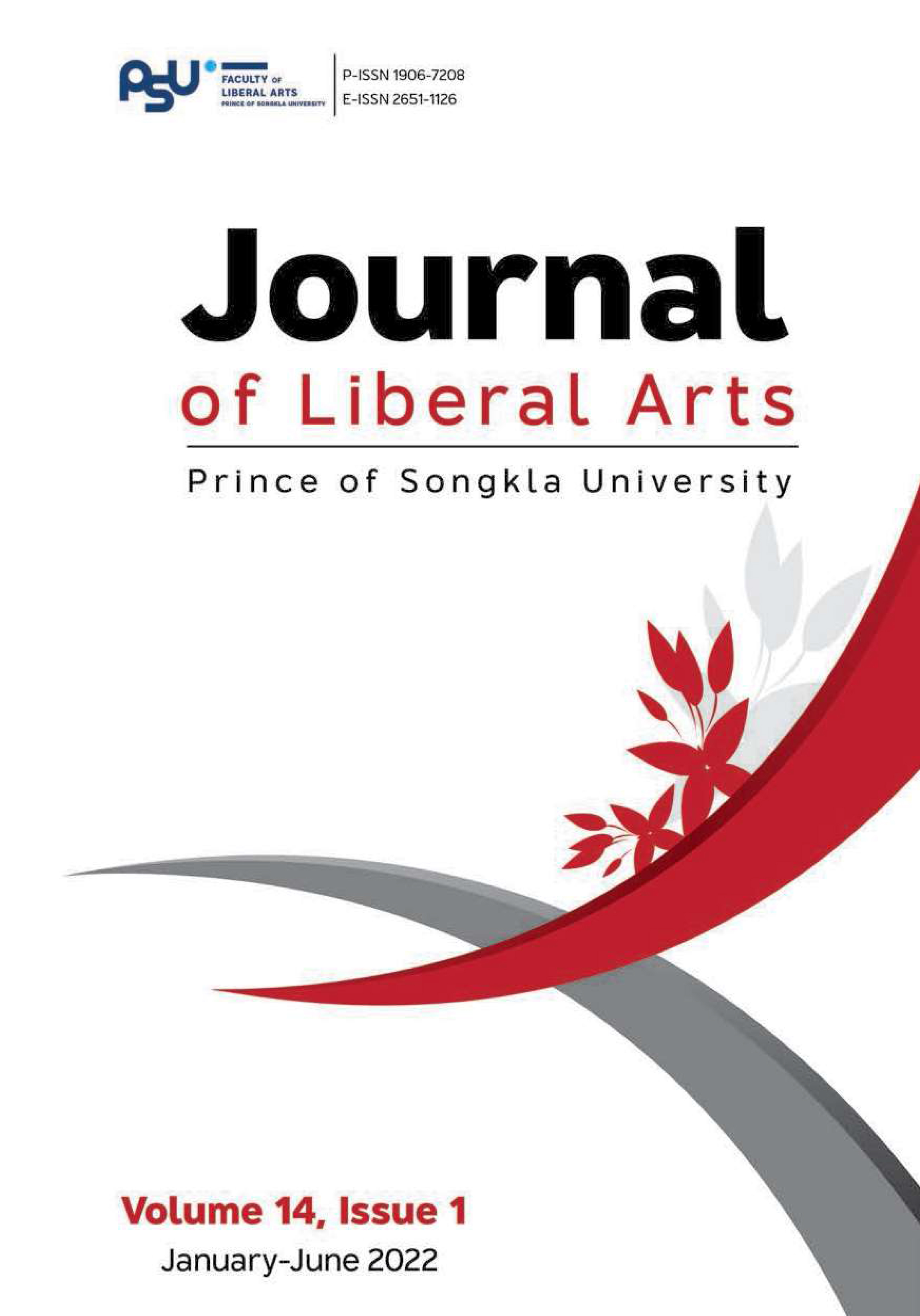Pragmatic Interpretations of Raised Arguments in English Novels
DOI:
https://doi.org/10.14456/jlapsu.2022.2Keywords:
pragmatic interpretations, the raised subject English novels, pragmatic discourse of given and new informationAbstract
This study investigates pragmatic interpretations of the raised arguments in English novels. The investigation of the raised arguments in this study covers four constructions in English. There are tough constructions (i.e., Peter is difficult to please), passive constructions (i.e., The book was sold by him), raising constructions (i.e., The book seems to sell well) and middle constructions (The book sells well). The previous studies in this field paid attention to the study of pragmatic interpretations of the raised argument in newspapers and academic prose. This study contributes to field by investigating the use of raised argument in English novels. The data collection in this study selected the best-seller novels (amazon.com), which are The Portrait of a Lady: The Turn of the Screw Washington Square written by James (2021), Pride and Prejudice written by Austen (2018) and The Hobbit written by Tolkien (2020). The contents in these novels is suitable for everyone to read. A corpus of 150,000 words contains 30 tokens. The framework used to investigate the raised argument follows Mair (1987) and Vicentini (2003). In order to gain the reliability and accuracy of data analysis, three English instructors were asked to validate the data analysis. The findings and discussion show that the raised arguments follow the pragmatic discourse of given and new information. Accordingly, this study will be useful for learners of EFL and ESL to develop pragmatic competence in writing novels and short stories.
References
Ackema, P., & Schoorlemmer, M. (1994). The middle construction and the syntax-semantics interface. Lingua, 93(1), 59-90.
Albrespit, J. (2009). Is the trust-ee trust-able? On English suffixes with a passive meaning. GAGL: Groninger Arbeiten zur germanistischen Linguistik, 49, 251-273.
Austen, J. (2018). Pride and Prejudice. Andrews McMeel.
Basilicon, D. (2003). The topic of small clauses. Linguistic Inquiry, 34(1), 1-35.
Becker, M. (2004). Learning verbs that lack argument structure: The case of raising verbs. LOT Occasional Series, 3, 115-125.
Becker, M. (2006). There began to be a learnability puzzle. Linguistic Inquiry, 37(3), 441-456.
Duboviciene, T., & Skorupa, P. (2017). Passive voice as a means of impersonal presentation of facts in English quality press. Svetimosios kalbos, 19(3), 38-47.
Gaily, M. M. A. (2014). Developing pragmatic competence of the sudanese university EFL learners via planned classroom instructions. 1(4), 40-49.
Gluckman, J. (2021). The meaning of the tough-construction. Natural Language Semantics, 29(3), 453-449.
Greenspon, M. D. (1996). A closer look at the middle construction [Unpublished doctoral dissertation]. Yale University.
Guerriero, A. S., Oshima-Takane, Y., & Kuriyama, Y. (2006). The development of referential choice in English and Japanese: A discourse-pragmatic perspective. Journal of Child Language, 33(4), 823-857.
Harris, W. C. (2004). Dr. Molly Feelgood; or, how I can’t learn to stop worrying and love ruby fruit jungle. EAPSU Online: A Journal of Critical and Creative Work, 1, 23-41.
James, H. (2021). The portrait of a lady: The turn of the screw Washington square. Arcturus.
Keine, S., & Poole, E. (2017). Intervention in tough-constructions revisited. The Linguistic Review, 34(2), 1-28.
Klingvall, E. (2013). Aspectual properties of the English middle construction. Working Papers in Linguistics, 3, 1-12.
Kul, M. 2007. The principle of least effort within the hierarchy of linguistic preferences: External evidence from English [Unpublished doctoral dissertation]. Adam Mickiewicz University, Pozna.https://repozytorium.amu.edu.pl/bitstream/10593/14724/1/
phd%20thesis.pdf
Mair, C. (1987). Tough-movement in present day British English: A corpus-based study. Studia Linguistica, 41(1), 59-71.
McEnery, T. & Xiao, R. (2005). Passive constructions in English and Chinese: A corpus-based contrastive study. Language
in Contrast. 6(1). 109-149.
Radford, A. (2009). Introduction to English sentence structure. Cambridge University Press.
Sheikh, F. A. (2013). A comparative study of NP-Movement in Kashmiri and English. Journal of Theoretical Linguistics, 10(2), 22-31.
Park, K. (2009). Explaining English Middle Sentences. Journal of Pan-Pacific Association of Applied Linguistics, 13(2), 125- 140.
Stojan, N., & Mijic, S. N. (2017). Passive Voice in Political Newspaper Articles. International Journal of Social Sciences, 3(2), 105-123.
Tolkien, J. R. R. (2020). The Hobbit. London: HarperCollins.
Vicentini, A. (2003). The economy principle in language: Notes and observations from early modern English grammars. Mots, Palabras, Words, 3, 37-57.
Wu, H., & Chitrakara, N. (2020). Agent or non-agent subject topics in English expository and fictional proses. SKASE Journal of Theoretical Linguistics, 17(5), 127-147.
Downloads
Published
How to Cite
Issue
Section
License
Copyright (c) 2022 Abhinan Wongkittiporn

This work is licensed under a Creative Commons Attribution-NonCommercial-NoDerivatives 4.0 International License.
The authors retain the copyright to their article but the Journal of Liberal Arts, Prince of Songkla University reserves the exclusive rights to first publication.






